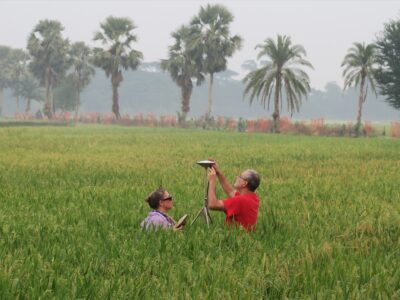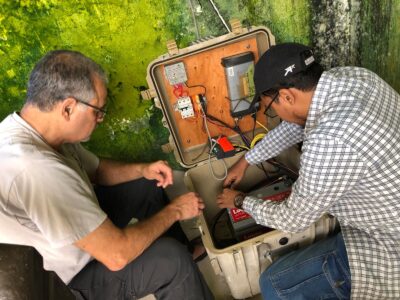
The next day we went to Khulna University (KU). Since there was no SET installation, many of the students came with me to work on the GPS. We had installed an already obsolete GPS at KU back in 2003, but it never worked well. The GPS was fine, but it had very little memory so a PC had to be attached to store the data and that failed all the time. We installed a modern instrument in 2014 and fixed the old one so we could have overlap between the two sites in order to combine them.

However, my contact at the Environmental Sciences Department had retired and the new chairman did not like having the equipment in personal offices as people change offices. With the help of some professors, and meetings with the chairman and dean, and exploring the building for suitable sites, we finally found a location acceptable to all. It took two hours. It is located on a balcony in a corner between two offices. With a larger crew, we set everyone to work, including sending people off to buy solar panels. It was going well enough that Salam and I went off to the Urban and Rural Planning Department that hosted the original GPS to find the data. The professor in charge of it was abroad, but I had a great discussion with the department chairman. After getting back to the other building, I helped finish the installation as the sun set.

The next morning we headed off to Barisal University. Two former Dhaka University students that I had worked with were now faculty there. Alamgir arranged for me to give a talk about what we were doing and my other work here. We hit bad roads and a slow route around them and just missed a ferry for a river crossing.

That gave me time to complete my PowerPoint, including pictures from our field work. When my battery ran low, John set me up with one of the 12-volt batteries for the installation with a power converted. We only arrived half an hour before my talk, barely completed during the trip. We said goodbye to Salam and Barkat, who left to return to Dhaka. After greetings, introductions, snacks and coffee, we all went to my talk. The seminar had no shoes allowed, so this was my first barefoot talk. Afterwards, there were almost no questions except from my friends.

However, as soon as we went outside, I was peppered with good questions. The students were too shy to ask them in public. We stayed the night in Barisal and then headed south for Khepupara and Kuakata along the coast, with Alamgir and Hasnat joining us.
For once, the roads were better than expected; we caught a ferry and got to Khepupara much earlier than I inspected. I installed a GPS system here in 2012 very close to a tide gauge, as at Hiron Point.

The tide gauge showed periods of rapid subsidence, but also slower subsidence. The GPS should give us more reliable estimates. We brought a repaired GPS receiver, a modern modem and fresh batteries. We all thought this would go quickly and be done well before Carol, who had to drive farther south to near the coast and scout for a site before she could install her SET to measure elevation changes and sedimentation rates. We were about done, but the new receiver was not recording any satellites.

We started checking cables, the lightning protector and the antenna. When John got a signal at the antenna, we decided to change the cables and lightning protector. However, we had to wait for the van that had one to come. Carol and the SET team was about half an hour farther south at Kuakata. When it finally arrived, we set to work, but when we finished, the system still didn’t record satellites. We tried the other receiver and it immediately got them.

A few more switches showed that we had a bad receiver that only occasionally recorded satellites. We swapped the receivers, reset the system and were done. But now we are one GPS receiver short.
The next day, Carol and the SET team still had one more site to set up. Rather than take time off, John and Chris wanted to explore setting up campaign monuments near the coast, which is eroding quickly — 200 meters over the last 30 years.

With monuments set up, GPS units can be sent here periodically to measure the position of each one. We started driving west along the embankment road and found that it quickly became impassable for cars. We were told it was drivable in winter, but not during the monsoon. We tried two roads in the other direction. We got farther, but still could not enough to be useful. We were told the other side of the embankment to the north was similar.

After some discussion, we changed tacks and decided to try to find the actual Khepupara Tide Gauge and see if we could put a monument directly on it. We drove to the north and stopped along the southern bank to the Nilganj River, where my maps showed it to be. We saw nothing. We talked to the local people and they said it had been moved to across the river and pointed it out. We went over and found it next to the ferry ghat and met the shopkeeper who looks after it. We also got the history of the tide gauge. It had been moved several times due to siltation and then was shifted to the opposite bank in 2016. This year a new automatic laser system was installed on a new tide gauge next to the tilted previous one. This history probably helps explain the variable rate. We paid the ferry to take us over and climbed the tide gauge. Since it is steel, we can weld a nut and short piece of threaded rod on the top.

The arm that holds the radar is also stainless steel, so John decided that would be best. We talked to the person in charge and he agreed to allow us to install the very small monument.
We found that we only had one good battery with us, so could not weld. Rather than wait for a battery to be sent out with the other van, we went back to the hotel and welded the threaded rod and nut there.

We could attached it to the tide gauge in the morning when we drove back north to our last site.
We spent the evening going out to the beach at Kuakata. This peninsula is the only place to watch both the sunrise and sunset over the Bay of Bengal. The amazing thing about this beach in summer is that the water is fresh, not salty.

The waves rolled in and broke like on other beaches, but this one is close enough to the mouth of the Lower Meghna River, with the combined monsoon flow of the Ganges, Brahmaputra and Meghna River, that the water is fresh. We walked along the beach, armored against further erosion with sandbags, including giant ones that looked like beached whales. We found the other team already there. Carol was sitting and talking to a family whose home was destroyed by coastal erosion.

They now live farther north. As darkness and high tide set in, we walked back past the crowds visiting the beach and went to dinner.



